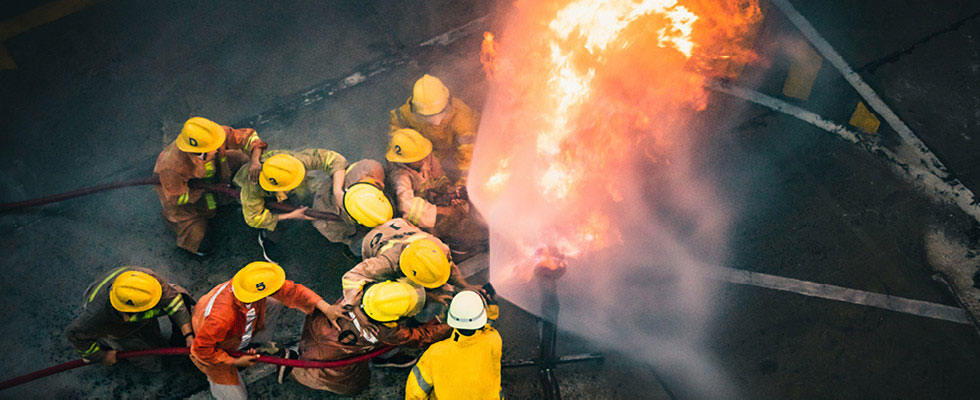
The job of a firefighter presents many hazards. Among these hazards is the risk of injury or death in a gas explosion. February alone saw multiple examples:
- In Loudoun County, Virginia, firefighters responded to a residence after gas odors were reported in the area. While they were at the scene, a massive explosion destroyed the residence, injuring 12 firefighters and two residents. Tragically, another firefighter was killed. Investigators found a leaking 500-gallon underground propane tank on location at the house.
- In Los Angeles, firefighters responded to a reported truck fire. They were in the process of putting out the fire when a massive explosion destroyed the truck, injuring nine firefighters, two of them critically. Investigators found that the truck was powered by compressed natural gas, and that one of its two compressed natural gas tanks BLEVE’d (boiling liquid evaporating vapor explosion — an extremely powerful event) as a result of the heat from the fire.
- In Ann Arbor, Michigan, a propane explosion destroyed a house. A firefighter was injured while fighting the fire. Investigators discovered that the homeowner had rigged up propane cylinders (apparently inside the house) to provide heat after his natural gas service had been cut off.
It is not known whether the negligence or fault of anyone was the cause of these incidents. If it was, injured persons and the families of those who died as a result should be able to sue those at fault for damages. But not necessarily so in the case of firefighters, who might be confronted with the professional rescuer doctrine, often known as the “Firefighter’s Rule.”
Under the Firefighter’s Rule, emergency responders who are injured in an incident in the line of duty may not sue those whose negligence or fault caused the incident. The rule generally applies not only to firefighters, but also to police officers and emergency medical personnel. It may seem unfair, and many commentators agree. The reasoning behind the rule is that emergency responders are well aware of the risks associated with their jobs, and they voluntarily assume those risks. Those who defend the rule also point out that emergency responders are adequately compensated by workers’ compensation, sick leave and disability programs paid for by taxpayers (this may or may not be true). They also note that citizens may be discouraged from calling for help if they believe they may be subject to liability.
It is important to remember, however, that this is one of those areas where the law can vary from state to state. Not all states follow the rule, and others have limited its application and have carved out exceptions. However, a decision of the Washington Court of Appeals in a recent natural gas explosion case — originally reported in BPN’s December 2019 issue — illustrates how the doctrine works in that state. The case is Markoff v. Puget Sound Energy.
Live Gas Line
On March 9, 2016, the Seattle Fire Department received a 911 telephone call reporting a natural gas leak. Nine firefighters arrived on the scene at 1:09 a.m. and notified the natural gas utility Puget Sound Energy (PSE) of the leak at 1:11 a.m. PSE did not take action to shut off the pipeline that was the source of the leak until much later.
After notifying PSE of the leak’s existence, the firefighters inspected a narrow passageway between two buildings and determined that the gas was escaping into the air from a threaded coupling along a steel service line attached to one of the buildings. The firefighters were unaware that gas had also escaped into and underneath this building. As the firefighters continued investigating, an unknown source ignited the gas in the building at 1:43 a.m., causing an explosion that leveled both buildings and injured the firefighters.
Subsequent investigation revealed two things. First, the gas line that had leaked was supposed to have been decommissioned in 2004. A contractor had been hired by PSE to cut and cap that line. It failed to do so, and the line was live and still charged with gas 12 years later in 2016. Second, the actual leak in the line was caused by the storage of personal items in the narrow space between the two buildings by individuals who lived in the area.
Lawsuit
Jeffrey Markoff, one of the injured firefighters, sued PSE and the contractor for negligence and intentional misconduct in leaving the gas line in question charged with gas. PSE moved to dismiss based on the professional rescuer doctrine, and the trial court granted that motion. Markoff appealed.
The appellate court thoroughly discussed the rationale behind the professional rescuer doctrine:
“The general rule in Washington is that a person who is injured while rescuing another may recover from the party whose negligence created the need for rescue. However, because professional rescuers assume certain risks as part of their profession, the general rule does not apply. When a professional rescuer is injured by a known hazard associated with a particular rescue activity, the rescuer may not recover from the party whose negligence caused the rescuer’s presence at the scene.”
Hidden Dangers
The court did, however, note that there is an exception to this rule “when a professional rescuer is injured by a hidden, unknown or extra-hazardous danger that is not inherently associated with the particular rescue activity.” Markoff invoked this exception, arguing that the firefighters did not know of PSE’s and its contractor’s negligence and that gas leaks had previously been reported in the same area.
In addition, they claimed, the firefighters had no knowledge that gas was escaping not only into the alley where they could perceive it, but also into an underground space beneath the building. Finally, they argued that PSE’s alleged negligence in failing to deactivate the line between 1:11 a.m., when it was notified of the leak, and 1:43 a.m., when the explosion occurred, created an additional unforeseeable risk.
Inherent Risks
The appellate court rejected these specific arguments:
“The firefighters do not allege facts indicating that they would have responded differently to the leak than they did had they known of the improper cutting and capping of the line or the previous reports of gas leaks. Nor do they allege that they would have responded differently had they known of the pooling of gas underneath the … building.
“All of the dangers created by the past negligence of PSE and its contractors, created by those who misused the narrow space between the buildings, and of the gas leaking into an underground space, were part of the same hazard that the firefighters were called to the scene to address: a gas leak.
“Injury from a fire or explosion is a risk inherent in addressing a natural gas leak, given that natural gas is known to be volatile and highly explosive. The firefighters do not show that the circumstances of this leak created a ‘new or unknown risk’ of a type not inherent in the danger of responding to a natural gas leak.
“The hazards faced by the firefighters, while significant, were inherent in the risks associated with responding to a natural gas leak. The trial court correctly applied the professional rescuer doctrine in dismissing all of the firefighters’ common law tort claims.”
Whether the Firefighter’s Rule can be invoked in the recent tragic incidents in Virginia, California and Michigan is unclear. But the Markoff case offers a clear application of the rule in the state of Washington to defeat the claim of an injured firefighter. Since our 2019 article discussing the case, the Washington Supreme Court denied review in 2020, letting the Court of Appeals decision stand as final; and in 2022, the Court of Appeals applied the professional rescuer doctrine to dismiss the claim of a sheriff’s deputy killed in the line of duty.


